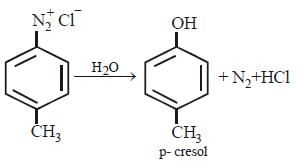Class 12 Exam > Class 12 Questions > Which of the following reagents will convert ...
Start Learning for Free
Which of the following reagents will convert pmethylbenzenediazoniumchloride into p-cresol? [1999]
- a)Cu powder
- b)H2O
- c)H3PO2
- d)C6H5OH
Correct answer is option 'B'. Can you explain this answer?
Verified Answer
Which of the following reagents will convert pmethylbenzenediazoniumch...

Most Upvoted Answer
Which of the following reagents will convert pmethylbenzenediazoniumch...
The correct answer is option 'B', H2O.
Explanation:
When p-methylbenzenediazonium chloride reacts with water (H2O), it undergoes hydrolysis to form p-cresol.
Hydrolysis of p-methylbenzenediazonium chloride:
p-Methylbenzenediazonium chloride contains a diazonium group (-N2+) attached to the benzene ring. When it reacts with water, the diazonium group gets replaced by a hydroxyl group (-OH) through hydrolysis.
The hydrolysis reaction can be represented as follows:
C6H4N2Cl + H2O → C6H4OH + N2 + HCl
Formation of p-cresol:
The product of the hydrolysis reaction is p-cresol. p-Cresol is formed when the hydroxyl group (-OH) replaces the diazonium group (-N2+) at the para position (opposite to the methyl group) on the benzene ring.
Overall reaction:
C6H4N2Cl + H2O → C6H4OH + N2 + HCl
In this reaction, water acts as a nucleophile and attacks the electrophilic diazonium group, leading to the displacement of nitrogen gas (N2) and the formation of p-cresol.
Other reagents:
- Cu powder (option 'A') does not have any role in this reaction. It is not involved in the hydrolysis of p-methylbenzenediazonium chloride.
- H3PO2 (option 'C') is a reducing agent and does not have the ability to hydrolyze the diazonium group. It would not convert p-methylbenzenediazonium chloride into p-cresol.
- C6H5OH (option 'D') is phenol, which is similar to p-cresol but does not have the methyl group. It is not possible to directly obtain p-cresol from p-methylbenzenediazonium chloride using phenol.
Therefore, the correct reagent to convert p-methylbenzenediazonium chloride into p-cresol is water (H2O) through hydrolysis.
Explanation:
When p-methylbenzenediazonium chloride reacts with water (H2O), it undergoes hydrolysis to form p-cresol.
Hydrolysis of p-methylbenzenediazonium chloride:
p-Methylbenzenediazonium chloride contains a diazonium group (-N2+) attached to the benzene ring. When it reacts with water, the diazonium group gets replaced by a hydroxyl group (-OH) through hydrolysis.
The hydrolysis reaction can be represented as follows:
C6H4N2Cl + H2O → C6H4OH + N2 + HCl
Formation of p-cresol:
The product of the hydrolysis reaction is p-cresol. p-Cresol is formed when the hydroxyl group (-OH) replaces the diazonium group (-N2+) at the para position (opposite to the methyl group) on the benzene ring.
Overall reaction:
C6H4N2Cl + H2O → C6H4OH + N2 + HCl
In this reaction, water acts as a nucleophile and attacks the electrophilic diazonium group, leading to the displacement of nitrogen gas (N2) and the formation of p-cresol.
Other reagents:
- Cu powder (option 'A') does not have any role in this reaction. It is not involved in the hydrolysis of p-methylbenzenediazonium chloride.
- H3PO2 (option 'C') is a reducing agent and does not have the ability to hydrolyze the diazonium group. It would not convert p-methylbenzenediazonium chloride into p-cresol.
- C6H5OH (option 'D') is phenol, which is similar to p-cresol but does not have the methyl group. It is not possible to directly obtain p-cresol from p-methylbenzenediazonium chloride using phenol.
Therefore, the correct reagent to convert p-methylbenzenediazonium chloride into p-cresol is water (H2O) through hydrolysis.

|
Explore Courses for Class 12 exam
|

|
Question Description
Which of the following reagents will convert pmethylbenzenediazoniumchloride into p-cresol? [1999]a)Cu powderb)H2Oc)H3PO2d)C6H5OHCorrect answer is option 'B'. Can you explain this answer? for Class 12 2025 is part of Class 12 preparation. The Question and answers have been prepared according to the Class 12 exam syllabus. Information about Which of the following reagents will convert pmethylbenzenediazoniumchloride into p-cresol? [1999]a)Cu powderb)H2Oc)H3PO2d)C6H5OHCorrect answer is option 'B'. Can you explain this answer? covers all topics & solutions for Class 12 2025 Exam. Find important definitions, questions, meanings, examples, exercises and tests below for Which of the following reagents will convert pmethylbenzenediazoniumchloride into p-cresol? [1999]a)Cu powderb)H2Oc)H3PO2d)C6H5OHCorrect answer is option 'B'. Can you explain this answer?.
Which of the following reagents will convert pmethylbenzenediazoniumchloride into p-cresol? [1999]a)Cu powderb)H2Oc)H3PO2d)C6H5OHCorrect answer is option 'B'. Can you explain this answer? for Class 12 2025 is part of Class 12 preparation. The Question and answers have been prepared according to the Class 12 exam syllabus. Information about Which of the following reagents will convert pmethylbenzenediazoniumchloride into p-cresol? [1999]a)Cu powderb)H2Oc)H3PO2d)C6H5OHCorrect answer is option 'B'. Can you explain this answer? covers all topics & solutions for Class 12 2025 Exam. Find important definitions, questions, meanings, examples, exercises and tests below for Which of the following reagents will convert pmethylbenzenediazoniumchloride into p-cresol? [1999]a)Cu powderb)H2Oc)H3PO2d)C6H5OHCorrect answer is option 'B'. Can you explain this answer?.
Solutions for Which of the following reagents will convert pmethylbenzenediazoniumchloride into p-cresol? [1999]a)Cu powderb)H2Oc)H3PO2d)C6H5OHCorrect answer is option 'B'. Can you explain this answer? in English & in Hindi are available as part of our courses for Class 12.
Download more important topics, notes, lectures and mock test series for Class 12 Exam by signing up for free.
Here you can find the meaning of Which of the following reagents will convert pmethylbenzenediazoniumchloride into p-cresol? [1999]a)Cu powderb)H2Oc)H3PO2d)C6H5OHCorrect answer is option 'B'. Can you explain this answer? defined & explained in the simplest way possible. Besides giving the explanation of
Which of the following reagents will convert pmethylbenzenediazoniumchloride into p-cresol? [1999]a)Cu powderb)H2Oc)H3PO2d)C6H5OHCorrect answer is option 'B'. Can you explain this answer?, a detailed solution for Which of the following reagents will convert pmethylbenzenediazoniumchloride into p-cresol? [1999]a)Cu powderb)H2Oc)H3PO2d)C6H5OHCorrect answer is option 'B'. Can you explain this answer? has been provided alongside types of Which of the following reagents will convert pmethylbenzenediazoniumchloride into p-cresol? [1999]a)Cu powderb)H2Oc)H3PO2d)C6H5OHCorrect answer is option 'B'. Can you explain this answer? theory, EduRev gives you an
ample number of questions to practice Which of the following reagents will convert pmethylbenzenediazoniumchloride into p-cresol? [1999]a)Cu powderb)H2Oc)H3PO2d)C6H5OHCorrect answer is option 'B'. Can you explain this answer? tests, examples and also practice Class 12 tests.

|
Explore Courses for Class 12 exam
|

|
Signup for Free!
Signup to see your scores go up within 7 days! Learn & Practice with 1000+ FREE Notes, Videos & Tests.


















